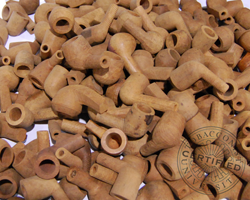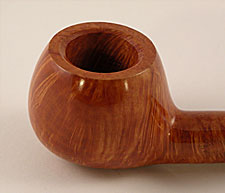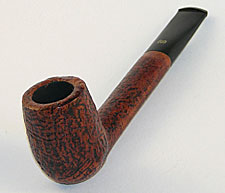 BRIAR BRIAR
Briar, or bruyére in French, is a dense burl found on the roots of the Heath tree (Erica arborea). The Heath tree, which actually looks more like a scraggly bush, is found throughout the dry and hot areas along the Mediterranean coast.
It is important to note that a burl "wood growth" is an aberration of the tree’s natural characteristics: roots, trunk, branches, leaves. To this day, this unique, naturally occurring "growth" is considered the ultimate pipe making material.
AGE
The age of the briar has a significant impact on the smoking qualities and aesthetic of the pipe to be carved from it. Before 1950 it was not uncommon to find briar that was over 250 years old. Well aged briar has a very tight grain and produces very smooth and cool smoking properties. Currently, most high grade briar pipes are made from 30+ year old briar. While the age of the briar effects the density, porosity, and grain pronouncement of the wood, 30+ year old briar still makes an excellent pipe.
GRADING
Over a century ago, a "first" grade pipe would have been considered flawless; no pits, grain disruptions, or fills. Today, many first grade pipes have pits, fills, and/or grain disruptions. Great first grade pipes may only have one or a few “insignificant” imperfections. So, it is difficult to say what is a "first" or "second" grade pipe today: there are no comprehensive industry standards. First and second grade pipes are defined by the manufacturer today, so one company’s first may be another company’s second, third, or worse. Rather than use "first" or "second" as a grading system, it is more common today to refer to better pipes as "high grade". Knowing the subjectivity of grading criteria, pipe lovers go to extraordinary lengths when selecting their pipes. It is not uncommon for a potential customer to scrutinize a pipe for hours, under varying light, and from every angle. While this scrutiny may seem extreme to some, a pipe lover knows that he/she is choosing a functional companion for a lifetime of enjoyment; so no amount of examination is too much.
GRAIN
Because it comes from a "burl", briar does not have concentric growth rings like traditional wood. Instead, the wood grows in a tight pattern that is either straight or bird's eye. Bird's eye is also referred to as burl grain because it is produced as a result of the irregular burl wood growth. The tight circular patterns of bird’s eye grain result at the end of the straight grain, where the wood grows inward and into itself.
The older the briar, the more pronounced and beautiful the grain will be: yet the grain of the briar, whether straight or bird’s eye, will not effect the way the pipe smokes. Both straight and bird’s eye/burl grain come from the same piece of wood and yield the same smoking characteristics.
On smooth finish pipes, which expose the grain, there are also sub-categories of grain patterns, including flame grain, straight grain, random grain, cross-cut, and cross-grain.

Straight Grain |

Burl Grain |
FINISH
Generally, there are three distinct methods for finishing a briar pipe: smooth, sandblast (see also rusticated), and carved. Pipes can also come in any combination of these finishes, be stained in a variety of colors and shades, or be painted as well.
A smooth finish is sanded and buffed to perfection, while a sandblast finish is achieved by "sandblasting" the briar with compressed air and sand (or other small particulates): sandblast pipes are also commonly called "rustic", but there is a distinct difference between sandblast and rusticated. A carved finish is achieved by shaping the wood texture and shape by hand, with a blade.

Sandblast

Carved |

Smooth

Painted |
Certified R&D Tobacconists: United States |
|
|
|
|
|

